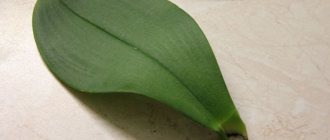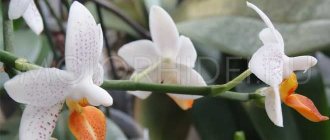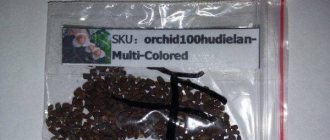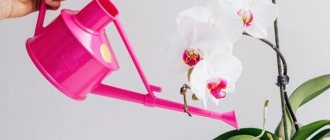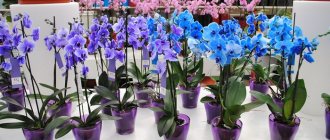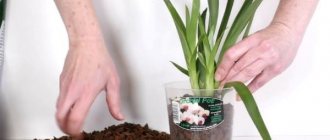The pinnacle in the art of keeping orchids in indoor culture is considered to be the successful cultivation of tropical beauties from seeds.
Experienced flower growers, with the help of the latest advances in biology, have learned to do what until recently was considered almost impossible.
Scientists have learned to extract and grow orchid seeds.
But the first stage of this process is obtaining the seeds themselves , which requires extensive knowledge in the field of botanical characteristics of orchids, experience in carrying out the pollination process, scrupulousness and enormous patience. Wondering how to pollinate an orchid at home?
Professional advice on how to pollinate phalaenopsis at home
Phalaenopsis has long ceased to be an exotic thing that is scary to touch and you just want to admire from the outside. Many flower growers, after purchasing another specimen, wonder how to propagate this orchid not only vegetatively, but also grow seedlings or obtain hybrid plants .
However, it is worth remembering that if pollination is successful, the plant spends a lot of energy on producing seeds and may not bloom for a long time. Below you will learn how phalaenopsis pollination occurs at home.
Which plant to pollinate
To obtain seeds, an orchid must be pollinated. Of course, not all specimens are suitable for this. It is better to choose fairly strong and large plants. If one orchid is larger than the other, then pollen should be taken from the larger plant and transferred to the flowers of the smaller one. Otherwise, you may end up with a small number of viable seeds.
When choosing an orchid, do not forget that divisions that have only a few pseudobulbs, as well as plants blooming for the first time, cannot bear fruit. After all, the process of growing seeds takes a lot of vitality from an orchid. As a result, the seedling may die. Such plants can be used as pollen donors. Pollination should be carried out on strong and robust orchids that can grow several pods at a time.
Pollination of phalaenopsis orchid
Prerequisites
Getting seeds yourself is practically the only way to get seedlings.
It is impossible to buy seeds of this plant.
In most cases, if phalaenopsis seeds are on sale, it is only a scam from unscrupulous sellers.
In addition, phalaenopsis seeds lose their viability very quickly , so you have to master the intricacies of independently obtaining seeds for sowing.
It is almost impossible to obtain phalaenopsis seeds.
Forms
In the plant world, 2 types of pollination :
- Self-pollination or autogamy;
- Cross.
In the case of orchids , self-pollination is not possible because the structure of the flower does not allow male pollen to reach the stigma of the pistil unaided.
Cross pollination can occur as:
- Within one plant - geitonogamy (when pollen from one flower lands on the stigma of another flower on the same plant);
- between different plants .
Possibilities
Phalaenopsis is characterized only by cross-pollination , i.e. Pollen from one flower lands on the stigma of another flower.
Pollen sometimes forms interspecific and even intergeneric hybrids , which are quite possible to obtain at home .
At the tip of the flower's stigma there is a column of pollen containing pollen.
The sticky “tails” of pollinia are designed to cling to the backs of pollinating insects and use them to get onto other plants.
In nature, self-pollination is impossible , but at home it is quite likely that when a flower is pollinated by its own pollinia, an ovary is also formed.
If you have several plants flowering at the same time,
hybrid pollination .
It is this type of pollination that allows:
- Get a variety of colors of flowers and leaves;
- Plant sizes.
It is difficult to predict what hybrid seedlings will be like , but among the diversity there may well be very interesting specimens.
Technology at home
With the necessary theoretical preparation, special skills for pollination are not required.
All you need is patience and accuracy .
A basic set of tools , such as tweezers and a toothpick, will be quite enough.
The pollination procedure can be divided into several stages:
Rules for pollinating phalaenopsis at home:
- Removing the boot cap. The anther cap must be separated from the stigma using tweezers or a toothpick . Typically, the pollinia are found inside the cap and rarely remain on the plant. They are 2 small yellow balls on a common sticky stem;
The anther cap must be separated from the stigma using tweezers or a toothpick.
- Extraction of pollinia from anther. The pollinia must be carefully separated from the cap, while not touching the anthers , but holding them by the “leg”;
- Inserting pollinia into the column niche. At the bottom of the column you can find a small recess into which you need to place the pollinium.
The pollinium should be the only object that touches the stigma of the flower.
How to determine the result
After such manipulations with a flower, you don’t have to wait long for changes.
Regardless of the result, the flower from which the pollinia was taken and the flower to which they were transferred will wither within 24 hours .
The first flower will simply dry out and fall off, and the fate of the second flower will depend on the success of the procedure.
If pollination has occurred, then after a day the hole in which the pollinia were placed will close .
The petals of the flower will begin to wither and dry out, but it will not fall off.
Instead, the base of the flower , by which it is attached to the main peduncle, will begin to swell , i.e. A seed box will form.
Formation of a seed box.
This process may take 6-8 months.
This is exactly what is needed to increase the capsule to its maximum and ripen the seeds.
It must be taken into account that when fully ripe, the capsule will crack , releasing dust-like seeds.
If cracking is allowed, then when sowing on a nutrient medium, difficulties may arise with sterilization of the planting material.
Therefore, after reaching the maximum box size, you need to monitor:
- Change in its color;
- If it turns yellow, pick it off, avoiding cracking.
How to pollinate
Only those flowers that have reached their highest bloom should be pollinated. In other words, they should bloom for several days. Only after this can pollen be applied to them, having first removed their own pollinia. To remove them, you should place the paper under the tops of the column, and then gently and lightly press on the anther cap in the direction from bottom to top. It is better to do this procedure with a toothpick. After such manipulations, the anther chamber should separate from the flower. Pollinia must be pushed out carefully. However, you cannot touch them. First, you should touch the stigma with the instrument, and only then the pollinia. In this case they will stick to each other.
Pollination of an orchid is carried out by pressing the stigma of the pollinia to the liquid. They are covered with a liquid substance. And you don’t have to be afraid that the pollinia will fall off.
As a rule, flowers react differently to pollination. Some of them begin to fade after two hours, and some after 2 days. To prevent infection by bacteria and rotting of the column, it is necessary to remove the petals at the very base. It is better not to touch the column while the pod is forming.
Complexities and subtleties
What is the fate of the phalaenopsis after receiving the seed capsule?
Some plants die after pollination and seed ripening , but this is not typical for orchids.
Of course, the ripening of seeds depletes the plant, but with proper care and timely feeding, phalaenopsis will be able to quickly recover and bloom again .
Is it possible to pollinate several flowers on one plant?
It is quite possible to pollinate all the flowers on the peduncle, especially since if even one flower is successfully pollinated, the untouched flowers will not bloom for a long time .
Pollinating several flowers at the same time significantly increases the chances of getting seeds , but leaving too many boxes on one peduncle is not recommended.
Pollinating several flowers at the same time greatly increases the chances of producing seeds.
It is better to remove excess ovaries so that the remaining ones can fully develop .
Is it possible to pollinate plants of different species?
Closely related species quite often form hybrids even in natural habitats.
In culture you can often find not only interspecific, but also intergeneric hybrids, such as:
- Doritenopsis;
- Asconopsis;
- Vandenopsis;
- Renanthonopsis.
How the pod develops
After pollination, the column gradually begins to swell. The ovary begins to enlarge. This is the first reaction to pollination. However, this does not mean that the process is completed and fertilization has occurred.
It is often possible to observe incompatibility between flowers and pollen. It manifests itself in different ways. The first signs may appear after a short period of time. The speakers just start to dry out. However, the same material that was used to pollinate other flowers can cause quite successful crossbreeding. There are cases when a completely normally developing pod gradually turns yellow. This can happen several months after pollination. In this case, the orchid will simply discard it.
If the pollination process was carried out correctly and fertilization occurred, then the ovary continuously increases in size. During development, three neat grooves may appear on it, corresponding to grooves that were noticeable even before pollination.
After six months, the pod grows to the size of a lemon. The growth processes at this stage are completed. Now the pod begins to gradually ripen. This takes a long time, full maturation occurs at approximately 9 - 10 months. And some varieties require even more time.
Orchid at home
Delicate and exquisite butterfly flowers have not lost popularity for many decades. This is not surprising, because the luxurious royal flower will decorate any interior and fit perfectly into almost any style. But, like any royal person, an orchid requires careful handling and proper maintenance conditions.
In this article we will talk about growing orchids at home.
Planting an orchid at home
The most popular variety of home orchid is phalaenopsis, mini phalaenopsis. We will consider the process of transplanting orchids using his example. The proposed algorithm of actions is suitable for most epiphytes.
If you have an orchid in your home, the first thing you should do for it is to carefully examine the root system. If you notice that the roots are covered with dark spots or are rotting, the plant should be replanted immediately. If the plant looks healthy, and even blooms, it is better to refrain from replanting. At least until the end of flowering. It is advisable to quarantine new plant specimens after transplantation for 2-3 weeks.
Difficulties in growing seeds
Rot on young plants
This occurs due to low temperatures and high air humidity. The affected plant is removed from the soil, removing its remains. The damaged parts are removed and then treated with a fungicide solution, placed in it for half an hour (can be replaced with a weak solution of potassium permanganate). Disinfect the pot and soil and place the treated orchid in it.
The appearance of mold in the container
It happens due to a violation of sterility. The situation is corrected as follows:
- A new mixture is being prepared.
- A little water is poured into the vessel and shaken.
- The contents are poured into a small container.
- Add 2 drops of growth stimulator, hydrogen peroxide and fungicide solution (1%) there.
- After 10-15 minutes, remove the seeds and place them in the newly prepared nutrient mixture.
Orchids: love with and without rules...
The Orchid family is the largest among flowering plants, it unites 25 thousand species. These plants were able to master all imaginable and unimaginable habitat conditions - from the deserts of Western Australia to the forests of Central America, from the remote mountain peaks of the Mediterranean to homes and offices around the world.
What is the secret of their success? In short - in deception. Although some orchids offer nectar rewards to the insects and birds that pollinate them, about a third of species economize on nectar and increase their chances of reproduction by cleverly deceiving the insects—visually, olfactorily, tactilely, or all three. Some orchids, such as Dracula, lure bees by imitating the appearance of nectar, while others attract midges by releasing unpleasant odors - from the smell of rotten meat or mushrooms to cat urine or a baby diaper. Some only make a promise by unfurling insect-like flower shapes. Others imitate male bees in flight, hoping to spark a territorial fight that will lead to pollination.
But perhaps the smartest deception of those orchids that offer sex is not entirely normal. One of the most ingenious and diabolical orchids in this regard is Ophrys, which some botanists call the “prostitute orchid.” Its pollination strategy is called "pseudocopulation" - a sexual deception that forces a radical reassessment of what a smart plant can do to a gullible animal. In the case of Ophrys, the animal is a relative of the bumblebee. The orchid does not give nectar or pollen as a reward; it seduces the male, imitating the female with its appearance, smell, and even tactile sensations that it gives to the insect.
These small orchids grow like weeds in the mountains of Sardinia. In appearance, they resemble a female bee with folded iridescent wings, buried in a green flower formed by the sepals of a real flower. To enhance the deception, orchids emit a scent that exactly replicates the pheromones of a female bee. A drone lands on the lower lip of a flower resembling a bee in an attempt to copulate. In the midst of his long and fruitless efforts, two yellow sacs of pollen, called pollinia, become stuck to his back with a quick-drying jelly-like substance. They look like a pair of plump oxygen tanks strapped to your back. A hunch finally dawns on the drone, and it abruptly flies off in search of real female company, carrying pollen to other plants.
What you need to germinate orchid seeds
Collected seeds
The collected material must be stored in maximum sterility under ideal conditions: good light, high humidity and warmth. If these conditions are not met, the collected material will simply become unsuitable for sowing.
The seeds also need to be disinfected. To do this, the material is placed in a chlorine solution (100 ml of water, add 15 g of bleach and filter everything thoroughly). Soak the seeds in the solution for an hour.
Equipment and its sterilization
To germinate seeds, you need to take a glass vessel that is hermetically sealed. To propagate plants, take a flask or jar (the container must withstand preliminary sterilization). A new packaged syringe is also being prepared.
Nutrient substrate for sowing
The seeds are grown in soil, special mushrooms and a sterile environment. You can prepare a special substrate according to the following recipe:
- 400 ml of boiled distilled water;
- fertilizer for ornamental crops;
- dessert spoon of sugar;
- 4 g honey;
- 80 g starch (potato);
- 1 tablet of activated carbon (crushed);
- 25 g banana puree.
Sugar, honey, fertilizer, puree and starch are added to the water in turn. Mix everything thoroughly and only then add crushed activated carbon. Place the mixture on low heat and keep until the components are completely dissolved with constant stirring.
The finished mixture is poured into ready-made containers, avoiding contact with the walls (otherwise there is a high risk of developing a rash). The containers are sealed with airtight lids and sent for sterilization along with the nutrient substrate.
Why can’t orchid seeds be grown in ordinary substrate? Orchid seeds lack endosperm, so the nutrient medium must contain the required amount of nutrients. In ordinary soil, such parameters cannot be achieved.
Sowing
The seeds are transferred to the nutrient substrate using a syringe. It is recommended to carry out the procedure over steam - in this case, microorganisms contained in the air will not enter the crop. The manipulation must be carried out very quickly to avoid contamination of the seeds.
Germination time
The duration of seed germination depends on the type of plant and ranges from 4 weeks to 8 months.
Care during development and subsequent transplantation
Grown seedlings are placed in a greenhouse and sprayed regularly. Transplantation of grown seeds is carried out in glass containers, previously disinfected with a solution of foundationazole. For planting, take steamed moss and pine needles.
Transplantation to a permanent place
After a year, the orchid sprouts are transplanted into a steamed substrate consisting of fern roots, moss and crushed pine bark (everything is taken in equal quantities). After mixing the listed components, add crushed activated carbon. Then take plastic cups, put a layer of drainage in them, and then a substrate. Young sprouts are carefully removed, the roots are washed and placed in new soil.
Rules of care
Caring for a crop grown from seeds is no different from standard orchid care:
- Illumination is plentiful for 12 hours. Mandatory protection from direct sunlight.
- Choose the temperature based on the species of the orchid. Observe daily temperature changes.
- Humidity level not less than 60%.
- Water only with settled water at room temperature. Do not allow moisture to stagnate under any circumstances.
Growing an orchid from a seed
The seeds contain negligible nutrients, so they need to find a source of nutrition. The seeds must be infected with a mycorrhiza-forming fungus. After infection, chemical processes occur in the seed that contribute to the germination of the embryo.
Thanks to symbiosis with the fungus, the orchid is enriched with necessary elements from the earliest stages of life. The fungus serves the orchid as a substrate for nutrition and further life.
Interesting! Orchid seeds can germinate even after 2 years!

